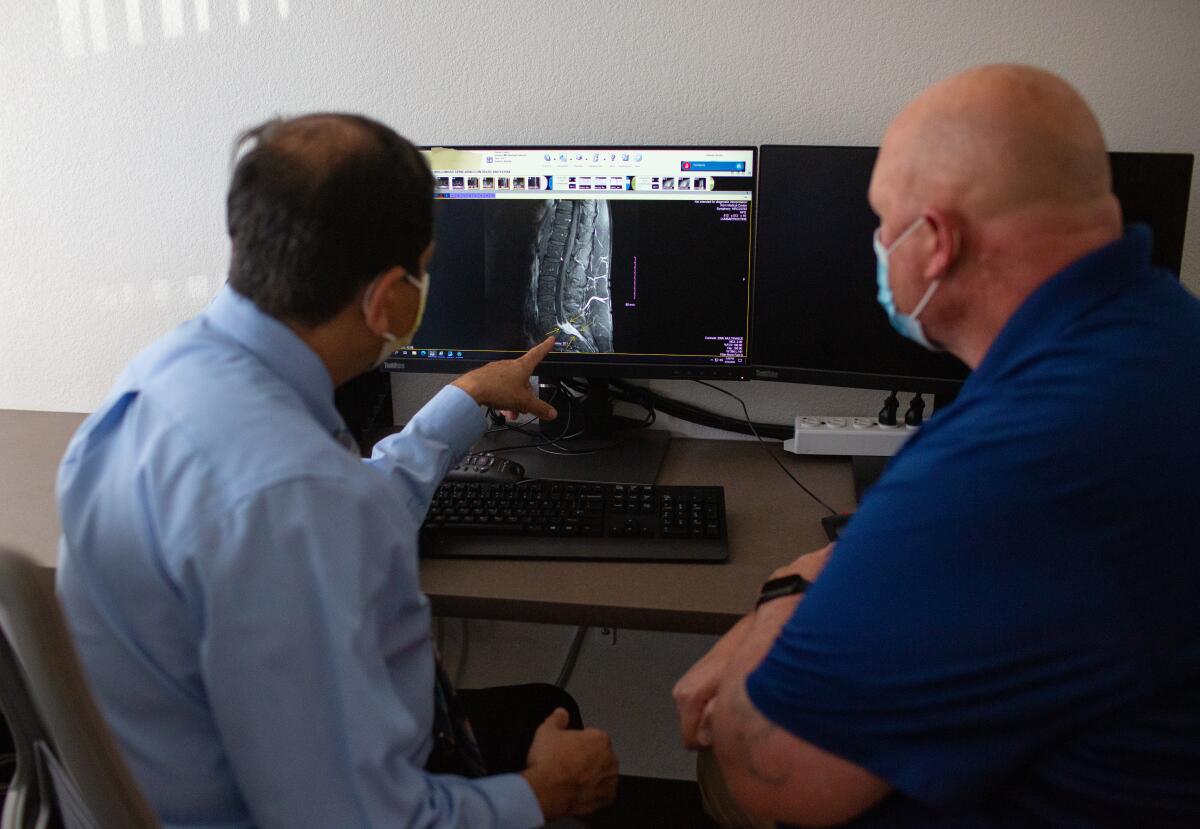How a Times column about loquats became required high school reading

- Share via
This month saw your humble columnist notch two huge literary achievements, the kind ink-stained wretches dream about.
I was a Pulitzer Prize finalist in the commentary category for my coverage last year about the political evolution of Latinos, making me just the third-ever Latino to achieve that distinction.
Maybe even more impressive, however, was that portions of a column I wrote a few years ago became mandatory reading for hundreds of thousands of high schoolers across the country.
The occasion was the AP English Language and Composition exam, that annual ritual for smarty-pants high schoolers that allows those who get a great score to earn college credit. The exact column, you may ask? Not the subject of my Pulitzer finalist nod, or my arcane stuff, or my street-level coverage of Southern California life. Or even my rants against In-N-Out, which is overrated.
Nope, the subject was… loquats. The small, tart fruit currently ripening on trees all across Southern California, which forever puzzle newcomers and delight longtimers and squirrels.
In 2021, I wrote a columna arguing that loquats, not citrus or avocados, are our “fruit MVPs” because they’re so ubiquitous and beloved by many of SoCal’s immigrant groups, including Latinos, Asians, Armenians and more. The piece also ridiculed an East Coast reporter who alleged that no one eats loquats in Southern California.
I’m very proud of it, but if I were to use one of my columnas to test college-bound high school seniors on their mastery of analysis and rhetoric, I wouldn’t have used that one. Someone tell that to CollegeBoard, the nonprofit that administers the Advanced Placement exams along with the SATs.
I found out about my columna‘s inclusion last week after the second round of AP English tests concluded. Friends of mine texted me that their children who took it were bragging to friends about how they knew the “loquat guy.” Students across the country took to TikTok to shout me out.
Some called it their favorite reading prompt. Others ridiculed my columna’s description of a loquat tree heavy with fruit as “glow[ing] like a traffic cone” or my stance that people who say no one eats loquats is an affront to Southern California’s “culinary soul.” Still others wondered what loquats were in the first place, how did they taste and where could they buy some.
In response, I created a TikTok account and filmed a short video of me silently staring at the camera while eating a loquat from my 4-year-old tree, which gave fruit for the first time this spring. “Hello I’m Gustavo Arellano the Loquat King,” a caption read. “What loquat questions can I answer?”
180,000 views later, I’m a TikTok loquat star.
But what exactly the AP test asked students about my piece remains a mystery.
A friend’s kid told me test takers were required to read a passage from my piece in the multiple-choice section and then answer questions about “word choice, claims, examples used, figurative language” and the like.
(I’m granting anonymity to the kid because CollegeBoard’s exam policy states that anyone who shares any content from exams that haven’t been publicly released will have their test scores “canceled, no retest will be permitted, and you may be banned from future testing.” Gosh, can’t you just give them detention?)
A CollegeBoard spokesperson declined to share the test questions about loquats with me because students are still taking it. They also asked I “not disclose any information about them” because CollegeBoard sometimes uses the same questions in future tests “and when information about them is shared, we have to discontinue their use.”
Too late!
I’m flattered, CollegeBoard. I’m not even angry that you didn’t bother to at least give me a heads-up. But I guess it’s par for the course: Although I did take AP English at Anaheim High with Ms. Sinatra, I skipped out on the test because I figured it was for dorks and goody two-shoes and I didn’t think I was either.
Oh, how wrong I was. I’ll stuff my sorrows by eating a bunch of loquats this weekend, because no one else eats them.
You're reading the Essential California newsletter
The most important California stories and recommendations in your inbox every morning.
You may occasionally receive promotional content from the Los Angeles Times.
The week’s biggest stories

Valley fever cases are expected to spike in California
- For the second year in a row, California is on track to have a record-breaking number of valley fever cases, which public health officials say are driven by longer, drier summers.
- Valley fever is a lung infection that people get when they breathe in spores of the fungus that lives in dry soil, according to the Centers for Disease Control and Prevention.
- While valley fever shares many of the same symptoms as other respiratory diseases, including COVID-19, it takes about one to three weeks for valley fever symptoms to develop, and the illness can last a month or more.
A new COVID subvariant spreads rapidly as Trump pivots away from vaccines
- A new, highly transmissible COVID subvariant has been detected in California — heightening the risk of a potential summer wave as recent moves by the Trump administration threaten to make vaccines harder to get, and more expensive, for many Americans, some health experts warn.
- This comes on the heels of Robert F. Kennedy Jr.’s announcement earlier this week that he was rescinding the federal government’s recommendation that pregnant women and healthy children get immunized against COVID, effective immediately.
Santa Monica residents go to war against Waymo
- There’s a battle brewing in Santa Monica with a fleet of unmanned, electric Waymo vehicles on one side, and exhausted, weary locals on the other.
- Using cones, cars and sometimes themselves, residents have taken to blocking the Waymos from entering their company-funded parking lot, so much so that the company has called the cops on them a half dozen times.
Trump administration threat to revoke Chinese student visas roils California
- Scholars and international students fear such an action could jeopardize the academic future of tens of thousands of Chinese students enrolled at colleges across the country, and threaten billions of dollars in tuition payments desperately needed by universities already facing the loss of research funding and other cuts effectuated by Trump’s education policies.
- The potential financial fallout is of acute concern in California, where Chinese students constitute the largest international group. About 51,000 Chinese nationals in California make up more than a third of the state’s nearly 141,000 foreign students.
More big stories
- California and L.A. lead the nation in dog attacks on postal workers.
- Coastal rail closed due to landslide risk to resume service between San Diego and Orange counties.
- Big Bear eaglet “hovers” for the first time but still hasn’t flown or fledged. What’s the difference?
- A 4-year-old Bakersfield girl facing deportation could die within days of losing medical care.
- In areas near January’s fires, rent is climbing faster than the rest of the county.
- A missing California influencer was found dead near an Arizona hiking trail after an extensive search, officials say.
- A father was killed in a Laguna Beach crash while teaching his 15-year-old daughter how to drive, police say.
This week’s must reads
After dominating the U.S. for decades, California avocado farmers have been lapped by Mexican growers offering cheaper fruit. But one local farmer is fighting back.
More great reads
- She ran the L.A. animal shelters. Why couldn’t she fix the problems?
- Did insurers collude to force homeowners onto state insurance plan? What to know from two blockbuster lawsuits.
- A daughter finds her mother dead in an L.A. homeless encampment. Was it an overdose or homicide?
- Killing wolves remains a crime in California. But a rebellion is brewing.
- How a pair of Palos Verdes altar boys grew up to be Soviet spies.
For your weekend

Going out
- Eats: Does the Thrifty ice cream in the freezer aisle taste the same as the stuff from the Rite Aid scoop counters?
- Experiences: Walking all 15.5 miles of Pico Boulevard in a day revealed hidden parts of L.A.
- More eats: Dine with history at L.A.’s landmark restaurants, founded in 1935 or earlier.
Staying in
- Television: “The Handmaid’s Tale” showrunners on the unattainable finale reunion: “It was heartbreaking.”
- Books: This book about parking will change how you see the world.
- Recipes: Here’s a recipe for summer pudding jam.
- ✏️ Get our free daily crossword puzzle, Sudoku, word search and arcade games.
Have a great day, from the Essential California team
Gustavo Arellano, metro columnist
Kevinisha Walker, multiplatform editor
Andrew Campa, Sunday writer
Karim Doumar, head of newsletters
How can we make this newsletter more useful? Send comments to essentialcalifornia@latimes.com. Check our top stories, topics and the latest articles on latimes.com.
Sign up for Essential California
The most important California stories and recommendations in your inbox every morning.
You may occasionally receive promotional content from the Los Angeles Times.








